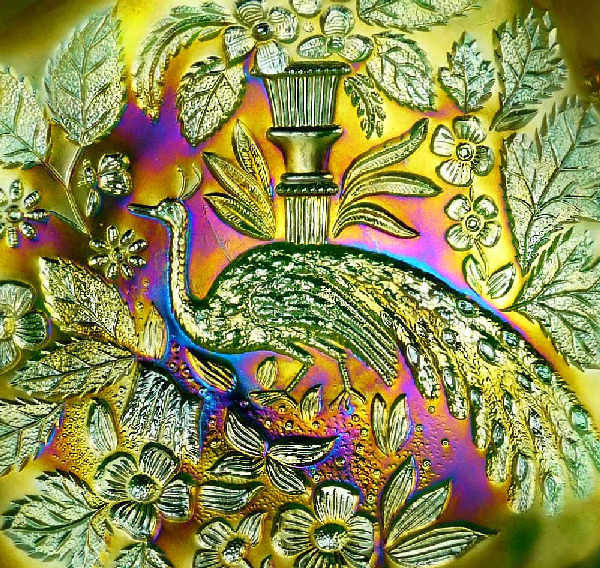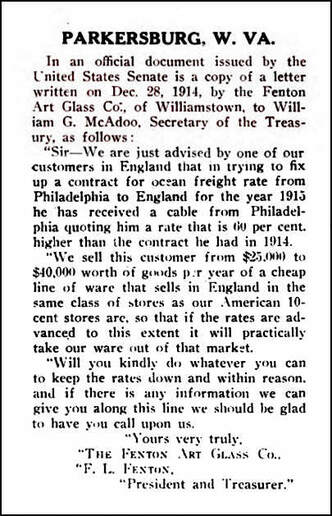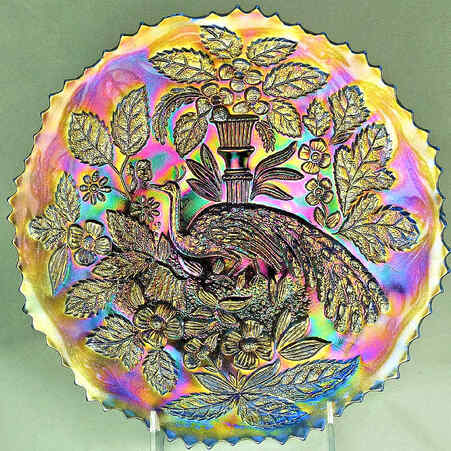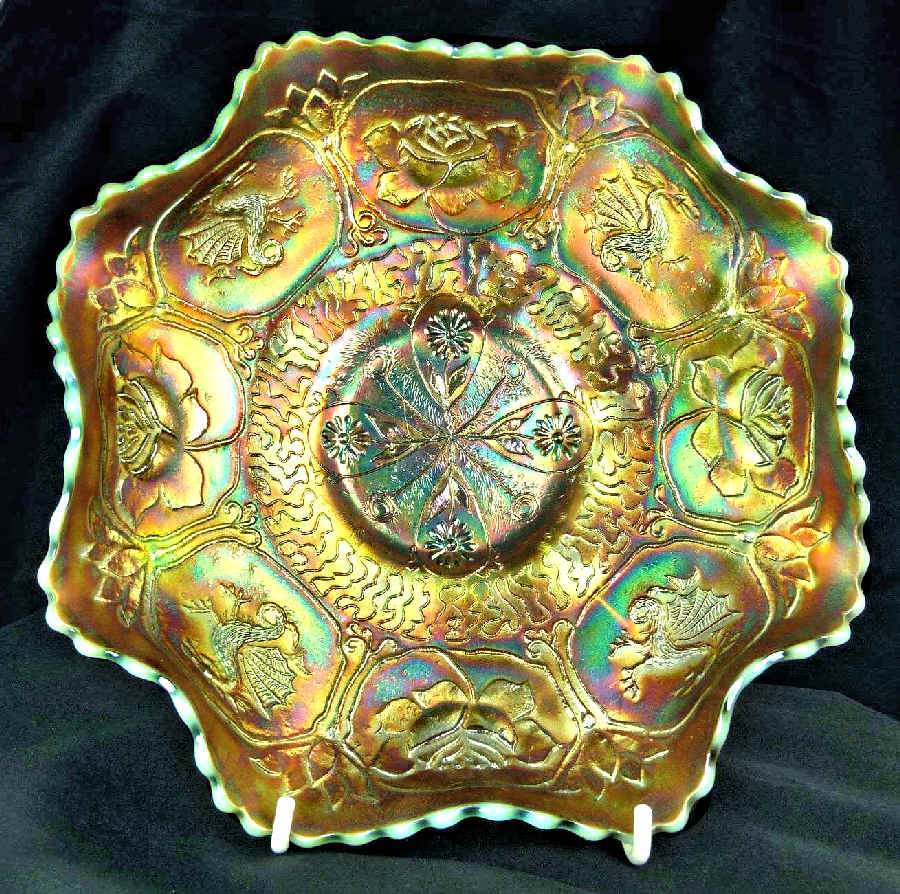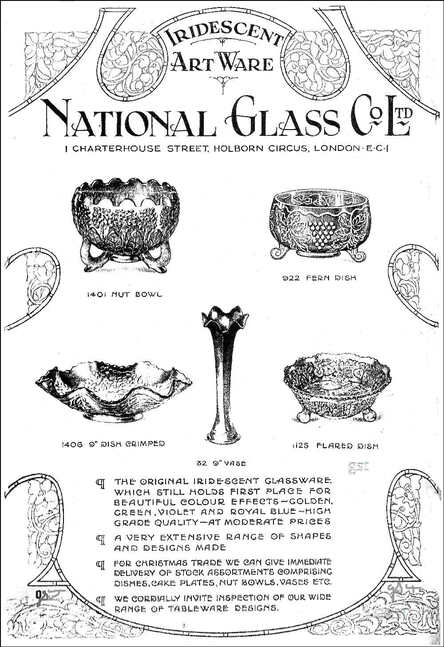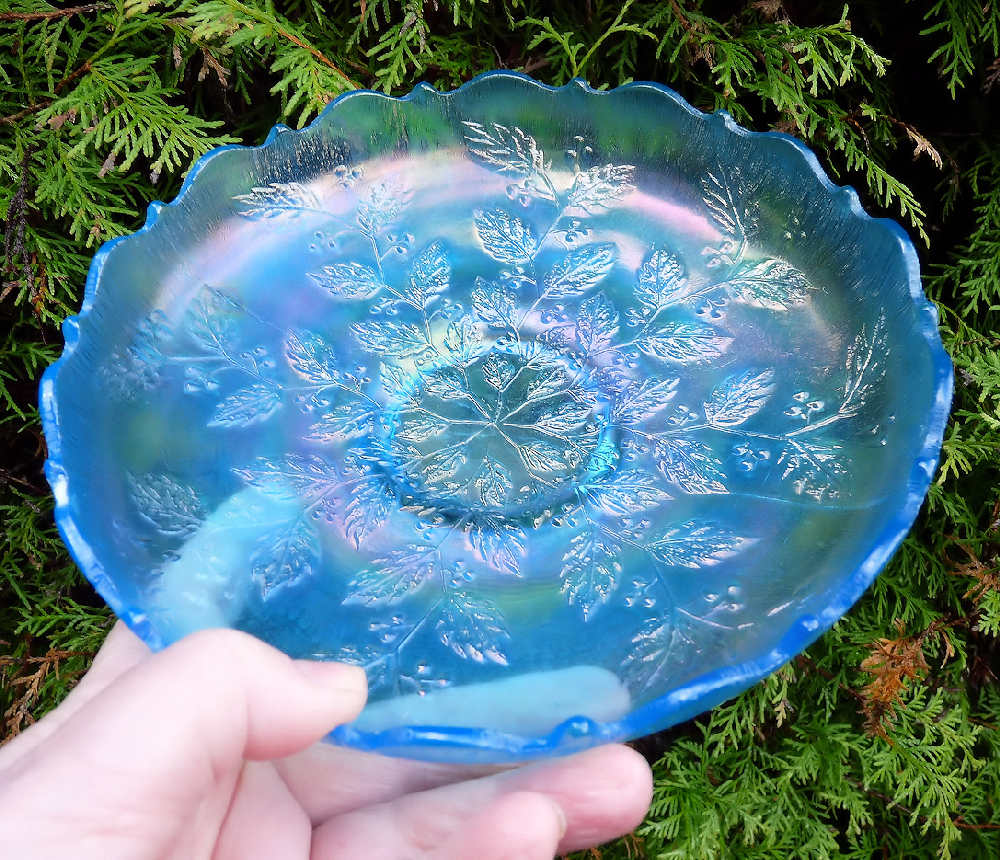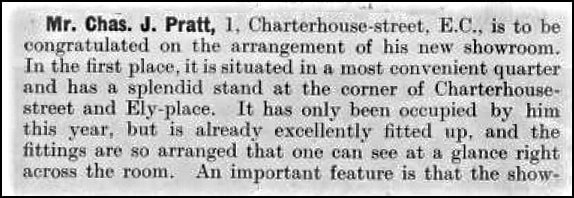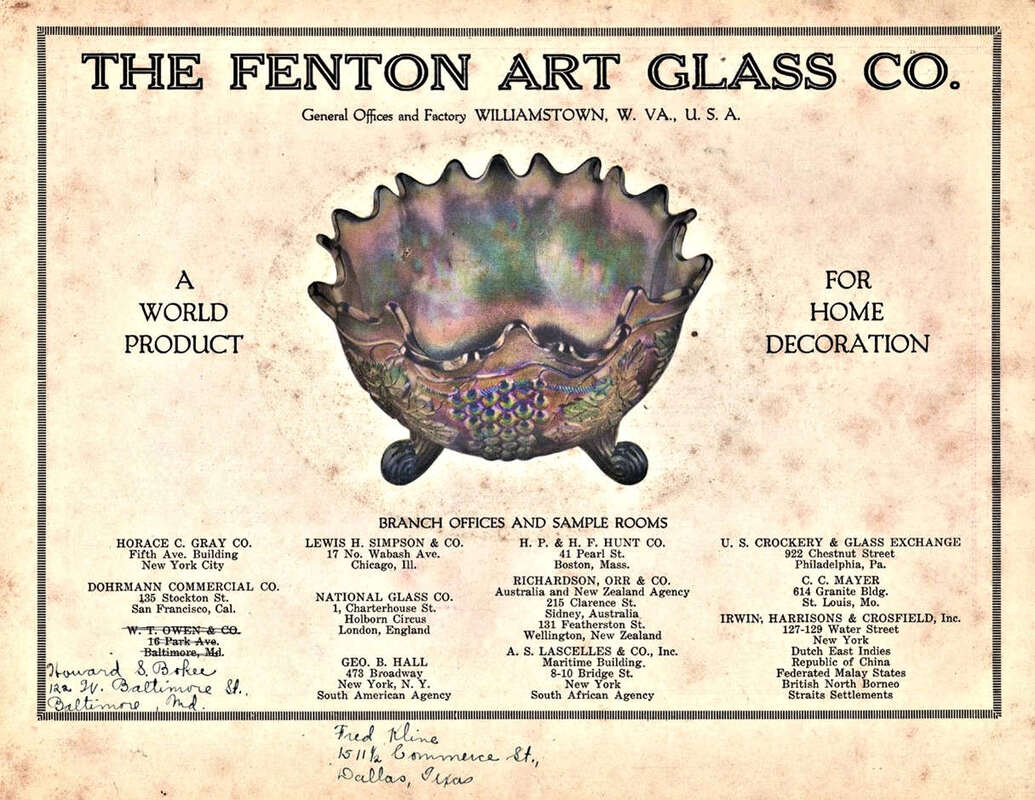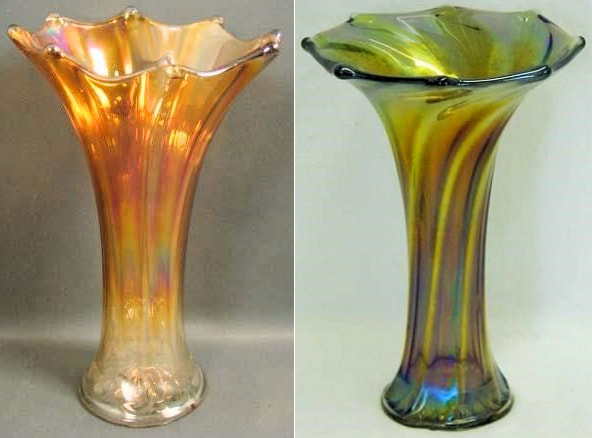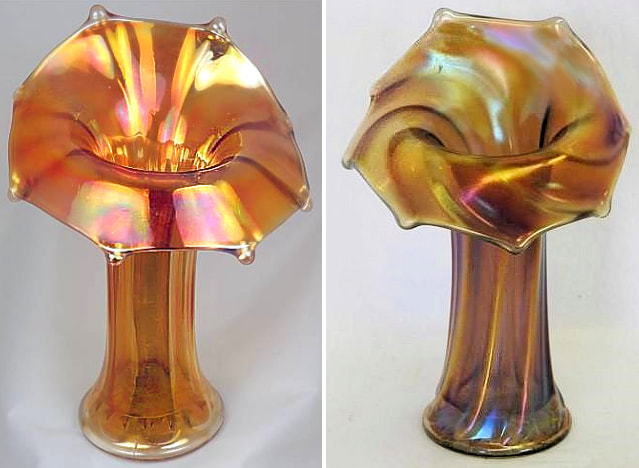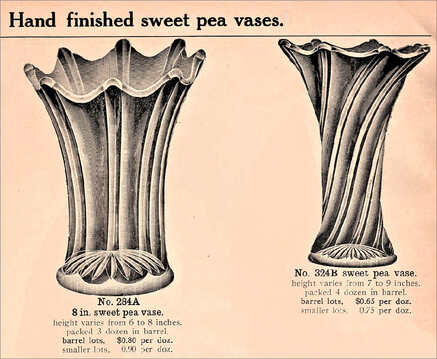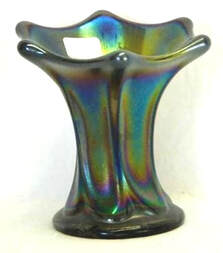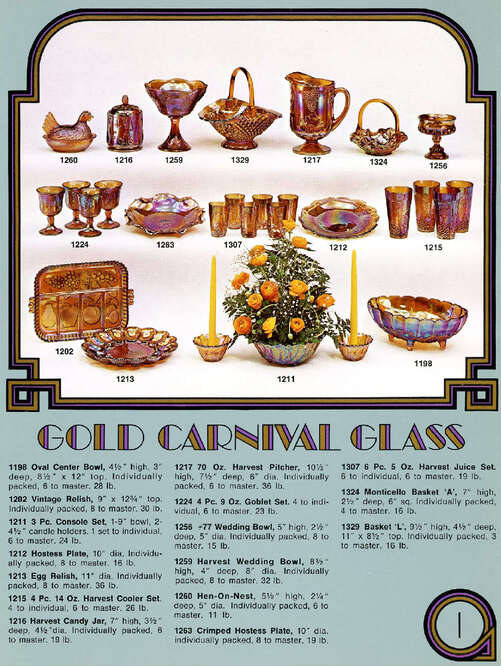NetworK ezine Issue 86. July 2022
Totally Devoted to Carnival Glass
|
Bright and Cheerful, without being Gaudy
In 1909, shortly after its introduction in the USA, Carnival Glass began to be imported into the UK by a far-sighted entrepreneur called Charles Pratt. He had already formed an association with Jefferson Glass in the USA and was importing – and heavily promoting – the new line of Chippendale Kryst-Tol. But in October 1909, a significant development took place: Pratt began showing the new Fenton line of what we now know was Carnival. And we believe this extract below is the very first mention of Carnival in a British trade publication. Extract from 1909 British Pottery Gazette.
The successful and growing business partnership between Fenton and Pratt’s new importing company would result in vast amounts of Carnival appearing in the UK, often in unusual colours and patterns. |
Above: detail from Fenton’s Peacock and Urn in green.
Photo courtesy S. Thistlewood. |
|
The clip above from the British Pottery Gazette in 1909 includes a description that we feel should forever be associated with Carnival – “bright and cheerful without being gaudy”. It perfectly sums up the appeal that the new glass must have had with the public at the time. Carnival in the Trade Press The British “Pottery Gazette” provides some fascinating contemporary insights for us. Here (on the right) is one from 1910, reporting on Charles Pratt’s glass stocks. The report went on to state that “the vases and other art shapes treated in this beautiful sheen on gold, violet and green grounds are novelties suitable for presents”. |
British “Pottery Gazette” May 1910.
|
In the following year, 1911, a Buyers’ Notes feature referred again to Fenton Art Glass and stated that their “products are highly artistic. There are many fancy shapes made in this unique combination of iridescent and colour schemes. These effects cannot easily be described verbally, they present different pearl-like lustres on emerald, Royal blue and amethyst grounds.” The following year, 1912, Buyers’ Notes revealed that “a large number of new samples of iridescent glassware has just been received in many pleasing and novel effects, Mr Pratt informs me that in all these the prices have been considerably reduced, so that many of them can sell retail as the 6d and 1/- lines, all for Christmas (*).” In April 1913, it was noted that at Pratt’s showrooms, “a new range of goods in iridescent effects is just now on show. The high-class colour effects are well maintained, and many of the new shapes are a distinct advance on anything previously produced”. Undoubtedly, Carnival was making a major impact on the glass scene.
* 6d was "six-pence" and 1/ was "one shilling" - they were part of the British currency back in 1912.
|
A Letter from Frank A snippet in the USA “Pottery, Glass and Brass Salesman” caught our eye. It was a copy of a letter (shown below), written in 1914, by Frank L. Fenton, to the U.S. Secretary of the Treasury. The contents of the letter are very revealing, and show us for the first time, the scale of the huge amount of glass that was being exported by Fenton to the UK via Charles Pratt's business in the early years of Carnival production. We have always known that a vast amount of Carnival was sent to Britain, based on observation, availability and archive reports. But we haven’t been able to put a figure on it … until now. In Frank Fenton’s letter (in which he was lobbying to have proposed freight rates kept low) he noted that Fenton were sending up to $40,000 worth of “cheap” lines of glass to a customer in England. That’s roughly well over a million dollars’ worth, in today’s purchasing power. That’s a lot of glass! Extract from “The Pottery, Glass and Brass Salesman” (USA) 1915.
The “customer in England” that Fenton referred to was, of course, Charles Pratt, who operated the wholesale agency known as the “National Glass Co” (no connection with the USA business of the same name). Pratt was undoubtedly a big fan of Carnival Glass, as the previous trade journal extracts indicate. He purchased large amounts from Fenton well into the 1920s (often in unusual colours such as celeste blue, aqua opal and red). Anecdotally, Charles Pratt also favoured green Carnival, which could account for the UK apparently receiving a good amount of that colour. |
Above: a Fenton Peacock and Urn plate, blue.
Below: a Fenton Dragon and Lotus bowl in rare aqua opal, one of several found in the UK. Photos courtesy S. Thistlewood. |
However, note the date of that letter above from Frank L Fenton – 1914 – just as the Great War was beginning. No doubt sales to the UK would have fallen off over the following few years. A report on the National Glass Company by Charles Pratt in the British “Pottery Gazette” that same year casts light on the situation. Pratt noted that he had travelled to the USA in order to “facilitate goods coming forward” (i.e. exported from the USA to the UK) – he hadn’t gone on this occasion to “discover new lines”. Pratt added that the War was affecting imports of the glass into the UK and the National’s representative had “joined the Colours” (i.e. he had enlisted in the army) and had gone to war.
But, fast forward to the early 1920s, after the War, and we see this splendid ad in the British “Pottery Gazette” (below). Business had undoubtedly picked up again and Fenton’s Carnival (referred to in the ad as “Iridescent Art Ware”) was being heavily promoted again.
|
The items in this amazing 1923 ad are, clockwise from top left:
Orange Tree (aka Fenton's Flowers) rose bowl (described in the ad as a “nut bowl”); Vintage fern dish, Panther footed berry (“flared dish”), Fenton Flute vase and what appears to be an Orange Tree ruffled bowl. |
Although the text of this ad indicates that the iridescent items were available in “golden, green, violet and royal blue” (marigold, green, amethyst/purple and blue) most of the pieces featured in this ad have also been found in the UK in the rare Fenton Carnival colour of red, and some also in celeste blue (see below). We learn more from the Buyers’ Notes regarding Charles Pratt’s Fenton Carnival for the National Glass Co., in 1924 regarding their “very extensive range of iridescent art ware”. The notes went on to state that “this is a comparatively cheap line of ornamental glass which will be so well known needless to describe it. It has had a long and popular run and it is being kept vigorous by the introduction of a number of new and interesting pieces. We were fortunate in being able to see some extremely new patterns which had only just arrived from the factory, including principally a new footed dish. By reason of their wonderful iridescent effect of light and shade upon the design that is moulded in the glass these pieces uphold the National Glass Company’s claim to the possession of a quite superior type of iridescent ware which is offered to trade prices that are right.” The celeste blue Holly bowl above was undoubtedly one of the Fenton items imported into England in the 1920s, thanks to Charles Pratt.
|
All the Carnival items shown in this feature above were sourced in the UK, so were likely items imported by Charles Pratt.
Further reading:
Howard Seufer Presents Crimping
In NetworK #85 (June 2022), we presented Howard's video which superbly illustrated how a swung vase was made.
In NetworK #85 (June 2022), we presented Howard's video which superbly illustrated how a swung vase was made.
|
Here is another of Howard's brilliant videos; in this one he shows - so very clearly - how Fenton used "tools of the trade" crimping devices to create the hand-finishing that makes Carnival Glass pieces unique. Simple hand tools, static hand and floor crimping tools, and complex mechanical devices all played their part in making Fenton’s wonderful finished edge treatments. The video was taken by the late Howard Seufer at Fenton Art Glass, and it is provided courtesy of Howard’s son, Marty. You do not want to miss this video. It shows so clearly how Fenton made such wonderful and intricate edge treatments on their glass. The article that accompanies it (the link is below) provides more detail about the various crimping tools that were used, many of which Fenton designed for their use. |
The video was filmed c 2000 - so the crimping tools, devices and techniques used in the factory are modern versions. Nevertheless, some of them would be immediately recognisable to the Classic Carnival glassworkers, and others have evolved over time from the earlier versions that were in use in the early Classic years.
Here is the link to Howard's video on Crimps (and previous videos that he made) which are here on our website: Howard Seufer Presents
We also feature more of Howard's knowledge and expertise in these very special articles on our website:
Here is the link to Howard's video on Crimps (and previous videos that he made) which are here on our website: Howard Seufer Presents
We also feature more of Howard's knowledge and expertise in these very special articles on our website:
|
Howard Seufer: Making a Press Moulded Carnival Bowl
|
Blast from the Past: Fenton Crimps by Frank Fenton
|
|
Update on Fenton’s Catalogue
In our NetworK 83 (April 2022) we shared some amazing pages from an undated Fenton catalogue, courtesy of Glass Paper Fanatics. Our research into it, and all the historical context we could amass, suggested that a date of c. 1912-13 was probably correct for its publication. But now we can add an important piece of information that narrows the date even further. On the cover of the catalogue is a list of branch offices and sample rooms where Fenton’s glass could be seen. The London address was Charles Pratt’s National Glass Co., which is listed as 1, Charterhouse Street, Holborn Circus, London. We were aware that Pratt had moved into this new office, but we did not know the exact date of the move. And now we do! We found the information in a 1913 issue of the British Pottery Gazette – see clip below. Extract from April 1913 British Pottery Gazette.
|
It shows clearly that Pratt had been at that address only since early 1913, not before (he was previously located at the Gamage Building in Holborn). So, based on all the evidence and context, we now consider that the publication date of that mystery Fenton Catalogue was 1913.
|
Two Imperial Vases
Imperial’s Morning Glory and Curled Rib vases are often confused with each other, especially when the mouth shape is the Jack-in-the-Pulpit (JIP) form (as we see here on the right). We see the confusion from time to time in our Facebook NetworK group, and so we decided to share these wonderful pictures and Imperial catalogue images to clear up the confusion. At first glance, they could be the same vase – just a different colour. Both have the same 8 ribs that end in tear-drop shapes at the top, and similar panels between the ribs, on the columnar body of the vases. But look again and you’ll see how those ribs are twisted (curled) around the vase and very clearly on the top section, on the smoke Curled Rib. Whereas on the marigold Morning Glory, they go straight up – no curl. Now, let’s look at them with flared tops (not JIP shape). An 11” high Morning Glory mid-size vase on the left in marigold,
courtesy Burns Auctions, and an 8” Curled Rib vase on the right in smoke, courtesy Seeck Auctions. The catalogue illustration shows the main difference between the two vases perfectly. The twisted ribs on the Curled Rib vase are actually part of the pattern cut into the mould itself. (They were not formed by twisting the hot glass vase after it emerged from the mould). There are other differences between the vases too. Where the ribs on Morning Glory meet the base, you can see a curving scallop shape; this is absent on the Curled Rib. The base sizes are different too (note, we are only referring to the versions of the Morning Glory with eight ribs at the moment - more about this below). Vase expert Joan Doty reports that Curled Rib has a 2⅞” base with a 20-point star on the marie, while the mid-size Morning Glory has a 3⅞” base with a 16-point star. |
Morning Glory vase on the left in marigold, courtesy S. Thistlewood.
Curled Rib vase on the right in smoke, courtesy Seeck Auctions. Both have the Jack-in-the-Pulpit mouth shape. Here they both are in the actual Imperial catalogue from 1910. Morning Glory vase on the left (No. 284 A)
and Curled Rib on the right, (No. 324 B). 1910 Imperial catalogue extract, courtesy Glass Paper Fanatics |
|
So, Morning Glory is a wider vase than Curled Rib and consequently, it took up more space when packing; this is evident in the Imperial ad above. Morning Glory vases (although smaller in height) were packed 3 dozen to one barrel at a cost of $0.80 per dozen; Curled Rib vases however were packed 4 dozen to a barrel and they cost less at $0.65 per dozen.
The colours they are found in differ slightly, as we have only seen Curled Rib listed in marigold and smoke, whereas Morning Glory is found in more colours (especially purple). One final important point of difference. Curled Rib is only known in one size, with that 2⅞” base. Morning Glory was a much more popular vase (Imperial even listed it in their 1910 catalogue as one of their “most important” pieces). It was made in three base sizes (small, mid-size and funeral – note that the small version only has 6 ribs, while the mid-size and funeral both have 8 ribs). On the right is a small Morning Glory vase in purple (courtesy Seeck Auctions) At 3¾ inches high, it is one of the shortest reported. |
|
Indiana’s Gold Carnival Glass
We are privileged to be able to show you this splendid page from a 1972 Indiana Glass catalogue, thanks to Craig Schenning. It needs little explanation as it is so comprehensive and so beautifully illustrated. Note that the #1211 3pc Console Set on the bottom row is often called Wild Rose, and the #1329 Basket is often referred to as the Canterbury Basket. The rest is self-explanatory. For a larger image of this catalogue page, click on the image, or here: Indiana Glass Florist Selection.
Right: 1972 Florist Selection Catalogue
from Indiana Glass. Courtesy Craig Schenning, the Dunkirk Museum, and the Glass Paper Fanatics. |
If you have missed any of the previous issues of NetworK and NetworK Specials, they are all here: Back Issues.
Privacy and the use of your information: we only use your name and email address to send you your FREE Carnival Glass NetworK ezine. We will not share your name or email address with anyone else, or use it for any other purpose. You can change your mind about receiving your NetworK ezine at any time by clicking the unsubscribe link at the foot of every issue, or by emailing us at [email protected]
Join us on Facebook
We would love you to come and join in the fun, and we invite you and your friends to join us all on NetworK's fast growing and very active Facebook Group!
We would love you to come and join in the fun, and we invite you and your friends to join us all on NetworK's fast growing and very active Facebook Group!


